Augmented reality is one of the fastest-growing advertising trends worldwide. The rapidly increasing adoption of smartphones and other AR-capable devices is one of the primary drivers of this growth, with 85% of U.S. adults owning a smartphone in 2021.
With companies across all industries beginning to use augmented reality in advertising, jumping on this trend is going to be important for staying competitive. Understanding how AR works as well as its limitations can help you develop unforgettable ad campaigns.
What is augmented reality (AR)?
AR uses digital camera equipment to “augment” the real world by adding virtual elements like animations or overlays.
While AR is still developing as a technology, it’s widely available in social media, gaming and advertising applications. Popular photo-sharing social app Snapchat is a great example of AR in action. Users can change their appearance using AR filters, like dog ears or freckles, allowing for more creativity and personal expression.
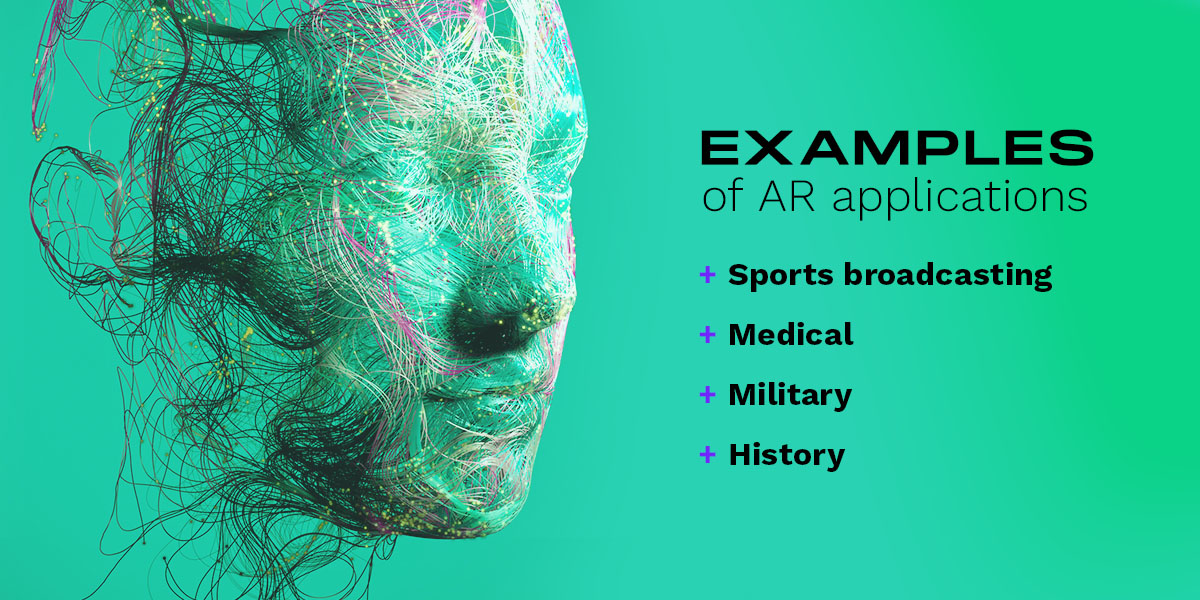
Some other examples of AR applications include:
- Sports broadcasting: Commentators can draw virtual lines on the field to analyze plays in real time.
- Medical: Surgeons sometimes use AR projections of 3D organs to assist with highly technical operations.
- Military: Fighter pilots might have an AR projection of flight data on their helmet visors, eliminating the need to glance down at the dashboard and helping maintain focus in critical moments.
- History: AR can help historians bring the past to life by showing what ancient civilizations might have looked like or superimposing tappable info bubbles onto the photos of ruins.
In advertising, augmented reality is an especially promising development because it enables advertisers to directly connect and interact with audiences like never before.
Augmented reality vs. virtual reality vs. metaverse
AR and virtual reality (VR) are two forms of extended reality (XR). While those unfamiliar with the industry often use these terms interchangeably, they actually refer to different experiences:
- AR: Augmented reality places computer-generated elements into a real environment using a digital overlay, often referred to as a lens or a filter. For example, if you looked at a window through an AR app, you might see an animated ghost moving around behind it. Out of all XR technologies, AR has the most potential applications because it has minimal hardware requirements.
- VR: Virtual reality is more immersive than AR because it allows you to enter a totally new world. However, because VR environments are completely artificial, you have less control over what happens than you do in an AR environment. VR also requires more equipment than AR.
- Mixed reality (MR): MR combines both AR and VR by attaching digital elements to real objects in a hybrid environment accessed through specialized MR equipment. Although MR is still in its infancy, it’s on a path toward strong growth — the MR market is projected to increase at a compound annual growth rate (CAGR) of 43.28% between 2022 and 2030.
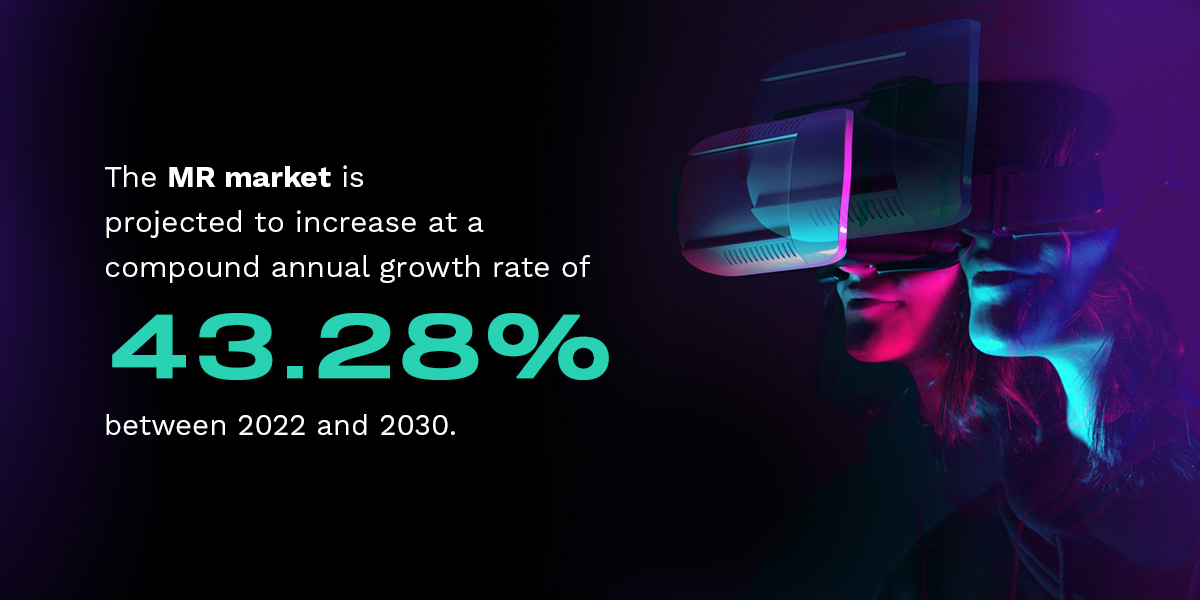
Think of it this way. AR puts the virtual into your world, while VR puts you into the virtual world. MR, on the other hand, fuses the two together.
You may also have heard of the metaverse, which is essentially a virtual world that people access using AR and VR technology. It’s a completely immersive, hyper-social iteration of the internet that has captivated many leading experts in the XR space.
Although it’s still a fairly new concept, the metaverse could offer promising advertising opportunities in the coming years. Experimenting with AR experiences could be the gateway to success in the metaverse once it becomes a widespread reality.
What is augmented reality advertising?
AR advertising is an emerging strategy that uses AR technology to create richer viewer experiences and provide more information about a brand. It works by using a smartphone’s camera to superimpose 3D models or other virtual objects onto your camera feed.
Here’s a common example. A brand places QR codes or scannable images in their storefront. When you scan those markers with your smartphone camera, a pop-up appears that takes you to a virtual try-on screen. From there, you can “try on” different items to see how they look on you before purchasing them.
For a more specific example, check out the Broadway Show Globe campaign we created with The Broadway League. To bring theater fans back after COVID-19 lockdowns, we created a campaign featuring an animated snow globe. Users could tap or shake the globe and be transported to a snowy 360-degree view of Times Square on their screen. From there, users could:
- Listen to holiday greetings from some of Broadway’s top celebrities
- Visit the campaign’s website
- Share the experience with friends
- Buy show tickets directly through the ad
This campaign is a great example of how brands can use AR to connect with their audiences on a deeper level, delighting viewers and driving higher sales.
The growing trend of AR advertising
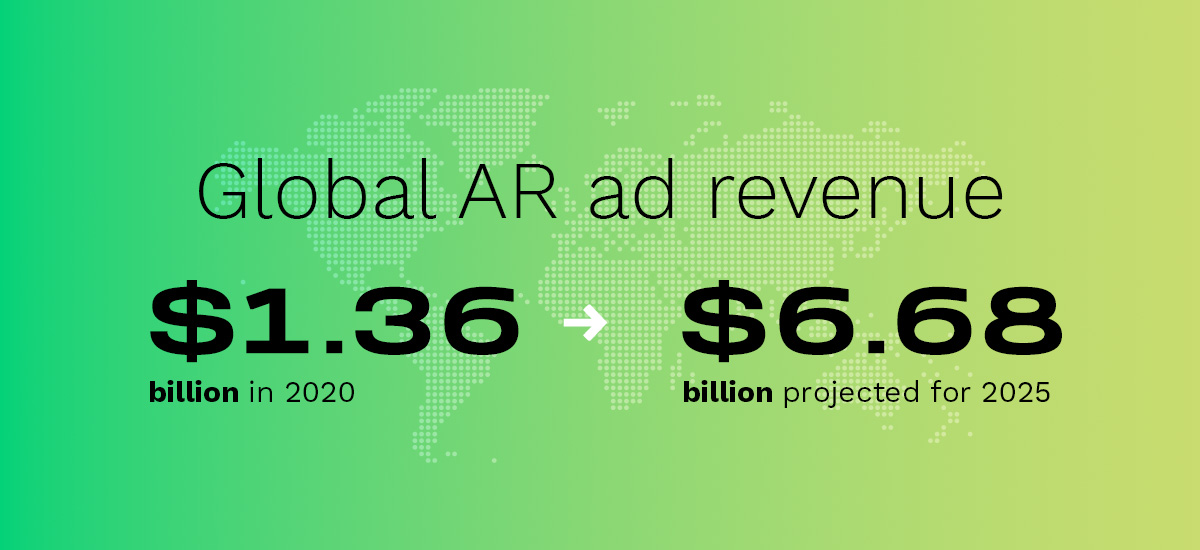
Although AR advertising is still relatively new to the scene, it’s a rapidly growing market. By 2025, global AR ad revenue is projected to grow to $6.68 billion — that’s a dramatic increase from 2020, when it totaled $1.36 billion.
The first true AR ad appeared in Germany in 2008. When magazine readers scanned an ad for a BMW Mini with their computer camera, a virtual model of the car would appear on the page. Moving the page allowed you to see the model from different angles. While it was low-tech compared to today’s AR campaigns, the ad was innovative for the time.
Why companies use AR in their advertising campaigns
Studies have revealed that a great AR ad campaign is typically more effective than more traditional advertising techniques. Here are some of the advantages of using AR in advertising.
Higher conversion rates
According to data from Shopify, AR ads often perform better than display ads — on average, the 3D AR ads in the study generated 94% higher conversion rates than their static 2D counterparts.
AR advertising enables you to directly embed your call to action into the interactive experience. Toys”R”Us Canada’s 2019 AR campaign is a great example of how this works.
The campaign used Snapchat’s Portal Lens technology to transport users to a virtual store where the toys came to life. Users could then swipe up to purchase their favorite toys from the Toys”R”Us website without ever leaving the app, creating a streamlined experience that guided customers through the sales funnel.
Better user engagement
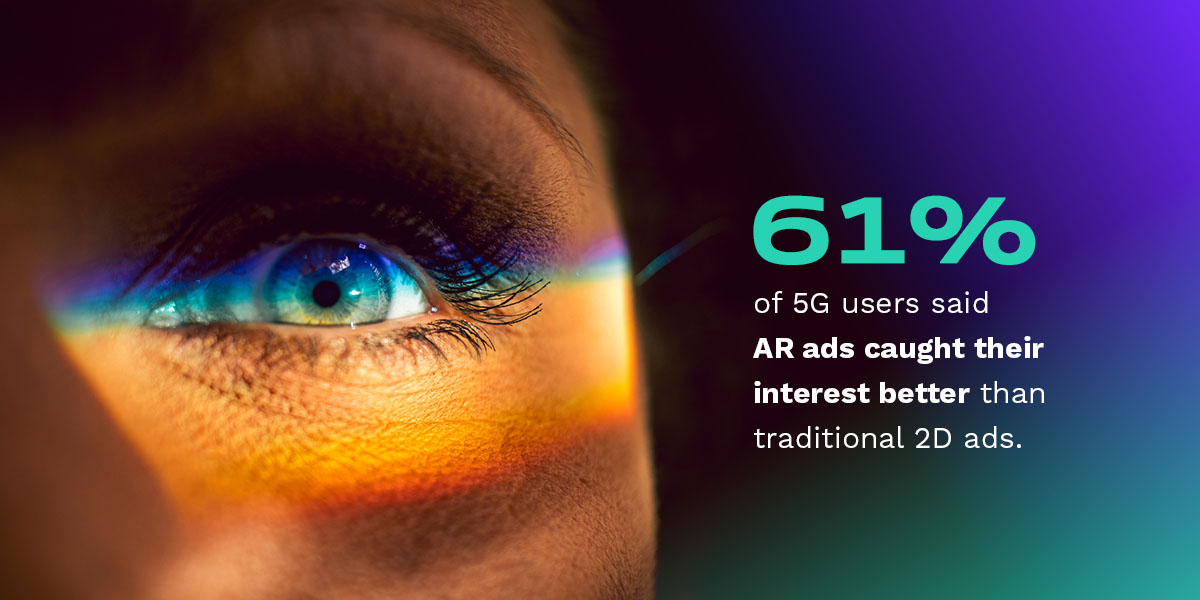
By gamifying advertising through AR experiences, you’re more likely to win over your customer base. In a 2021 survey, 61% of 5G users said AR ads caught their interest better than traditional 2D ads.
Entertainment is one of the most prominent use cases for AR technology. According to data from Deloitte Digital and Snap Inc., 65% of consumers use AR technology for fun. Consider the overwhelming success of the mobile game Pokémon Go. A week after its 2016 release, more than 10 million players worldwide had downloaded the game.
Customers have now come to expect that level of engagement when interacting with brands. In fact, 68% of respondents in a study agreed or strongly agreed that engaging AR ad experiences reflected positively on the brand in question.
More memorable connections
Immersive AR experiences help brands develop stronger emotional connections with their customers. AR makes your audience more likely to remember your ads by immersing them in the experience and promoting active engagement. According to industry research, AR experiences result in 70% more memory encoding than traditional static ads. Part of AR’s memorability may stem from almost three-quarters of consumers being more likely to focus on augmented reality ads.
That’s exactly why some companies have begun incorporating AR technology into their training and onboarding programs. Allowing employees to work through an AR-powered first aid simulation is far more engaging than requiring them to watch a series of videos on the topic. That same logic goes for connecting with consumers through AR-powered advertisements.
That said, brands need to think beyond creating realistic 3D assets of their products to develop more immersive AR experiences. Aside from alleviating purchase anxiety, how do you want customers to feel after engaging with your AR creative? Taking the time to focus on this question can help guide your campaign strategy.
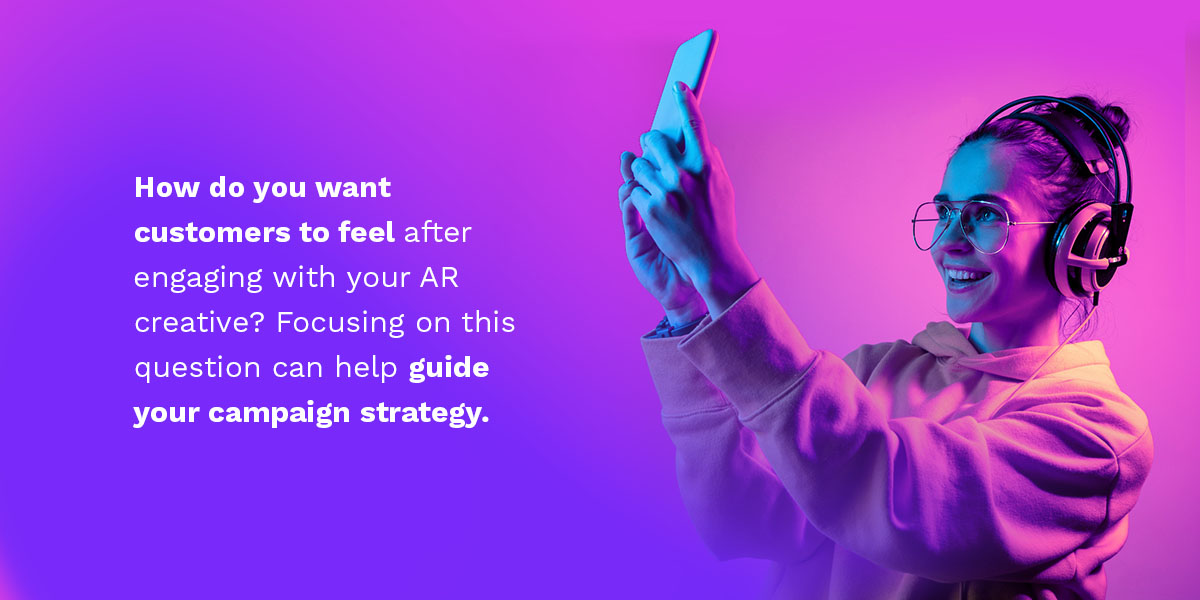
Expanded brand reach
Today’s youth and AR technology are maturing together. Gen Z — those born between the late-90s and the early-2010s — form the majority of AR’s user base. In a study by Snap Inc., 93% of Gen Zers are interested in using AR for shopping experiences.
It makes sense that some media organizations have nicknamed Gen Z “Generation AR.” However, with an even shorter attention span than millennials, Gen Z can be tough to reach. Presenting a novel, entertaining experience is key to catching and holding their attention for more than a few seconds. So if you want to reach this young, tech-savvy audience, it’s time to start incorporating AR in your marketing strategy.
Increased sales
It’s no secret that AR boosts business. That’s because it’s a great vehicle for creating more personalized customer experiences. In 2021, customers were 41% more likely to consider buying from a brand that offered a custom AR experience.
Studies have demonstrated that AR advertising may have the most significant impact on consumer choices when it comes to less well-known brands. In one field study, researchers set up an AR-equipped sampling fixture in a cosmetics store. While shoppers only focused on a few brands and products when using traditional testers, they ventured outside their comfort zone when in front of the AR fixture.
The same researchers also studied how AR impacted users of the store’s app. Consistent with the findings of the in-store study, shoppers who used the in-app virtual try-on feature spent more time browsing and were 19.8% more likely to make a purchase than those who did not use the feature.
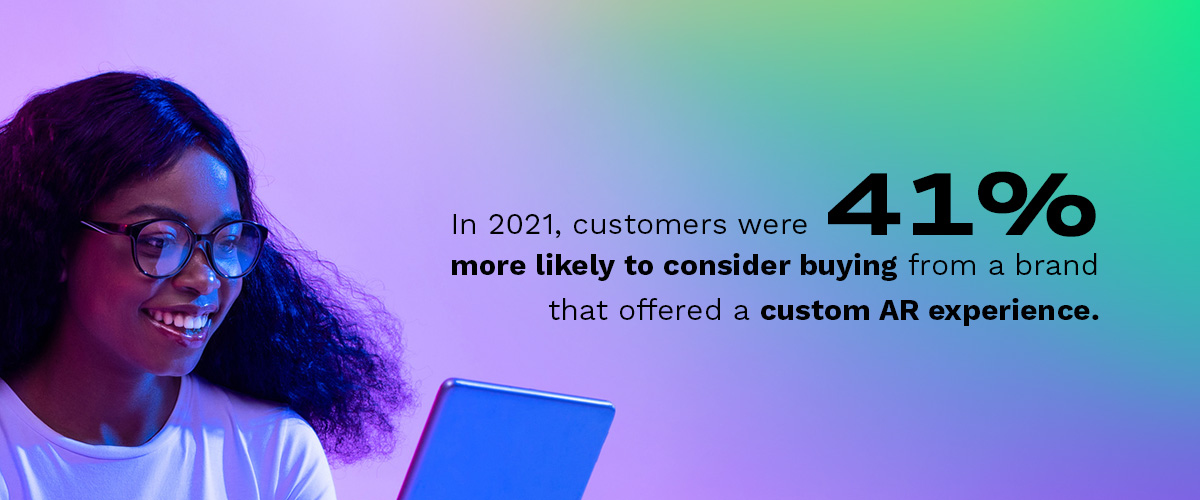
Top industries leveraging AR in their advertising campaigns
While there’s a use for AR in almost every industry, the following sectors have produced some of the most successful ad campaigns in recent years.
Beauty
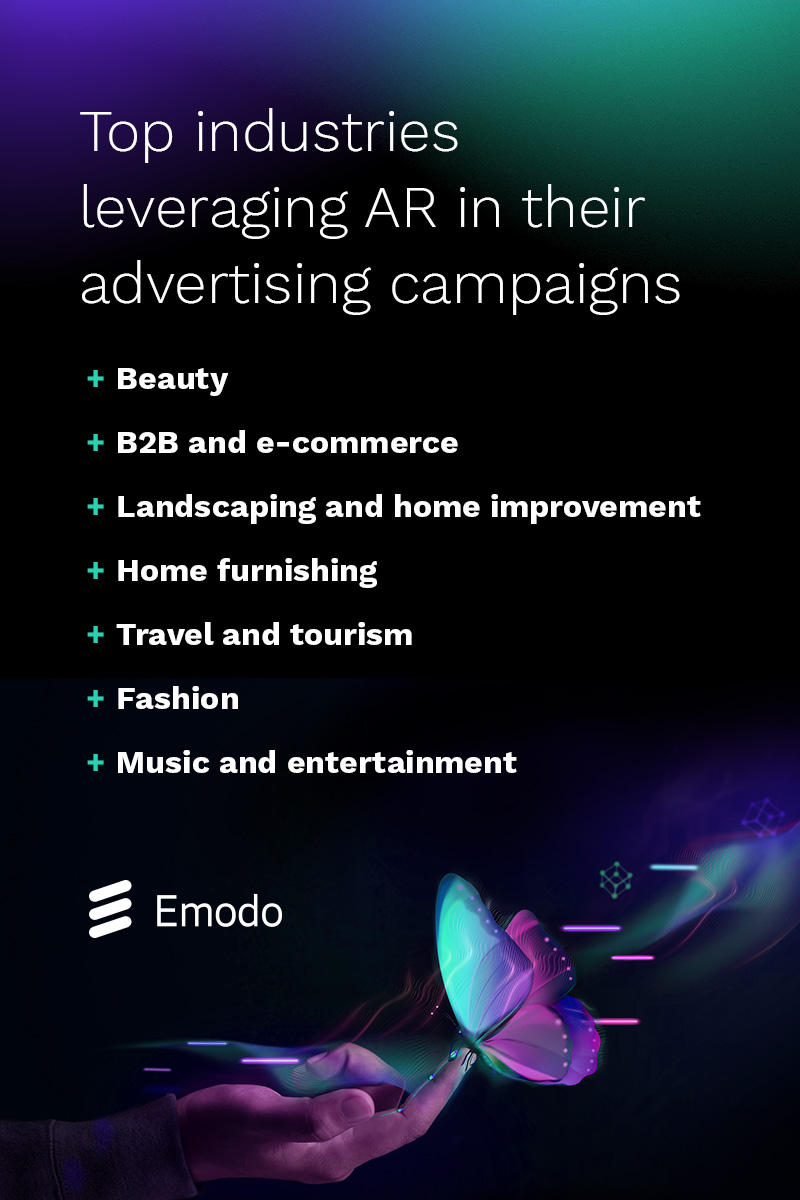
The beauty industry has been using AR in advertising and shopping experiences for several years now. Prominent beauty retailer Sephora allows customers to virtually try on makeup through a feature in their app. Using their front-facing camera, shoppers can apply lipsticks, foundations, eyeshadows and more without needing to go to the store in person.
Of course, there are some products customers have to try in person, like skincare or fragrance. Estée Lauder, one of the most prominent cosmetics brands in the world, came up with a creative solution to this problem. To promote the 2021 autumn fragrance collection, the brand used a gyroscopic Snapchat filter that projected floating perfume bottles onto the user’s surroundings.
Users would tap on the bottle they were most interested in, which would trigger an experience inspired by that fragrance. For example, tapping on the Dream Dusk bottle would transport you to a pastel pink landscape complete with birdsong and falling petals.
B2B and e-commerce
Providing a smooth, streamlined sales experience is critical for making sales in the B2B and e-commerce spheres. The better the experience you can provide, the greater your chance of closing an important sale.
That’s why AR is so helpful for B2B sales. One of the best uses of AR in advertising is demonstrating a product’s functionality. The target audience can interact with a 3D AR model of a company’s product to get a better understanding of features that might be difficult to demonstrate in person.
B2B sellers often deal in highly specialized equipment, which is typically difficult to move due to its size and weight. Lugging around an office photocopier between sales appointments, for instance, is much easier said than done. The same goes for heavy equipment like bulldozers and excavators.
AR product demos are great for illustrating the benefits of such products. AR allows sellers to upsell and cross-sell these products without the client visiting their location.
It also enables sellers to showcase their entire product portfolio with little more than a tablet or smartphone. A heavy equipment dealer could “bring” their machinery to their clients using AR demonstrations. If the client expresses a need for something different than the product they’re looking at, they can just switch to another product demo without ever having to set up an in-person sales appointment.
Landscaping and home improvement
Any sort of renovation or landscaping work can be an intimidating investment, especially for new homeowners. You really can’t know how your vision will turn out until the project is complete. Augmented reality can show customers how well their ideas translate into real life, which can help them feel more confident about their investment.
Contracting companies can leverage AR programs to help customers visualize the end results before purchasing materials. For example, a salesperson for a window company could create an app that allows homeowners to virtually “try on” different window frames to see how they look in their own homes. The program empowers the customer to make adjustments to designs in real time, making it easier than ever to create a project plan they will love.
Home furnishing
Buying new furniture is a major investment. AR advertising allows customers to learn everything they want to know about a piece, including how it looks in their homes, before committing to making a purchase.
Swedish furniture giant IKEA rolled out IKEA Place, their augmented reality app, in 2017. The app allows users to superimpose true-to-scale 3D models of IKEA furniture in their homes to see how it would look before purchasing. Users can also access specially curated furniture collections and product highlights to inspire their designs.
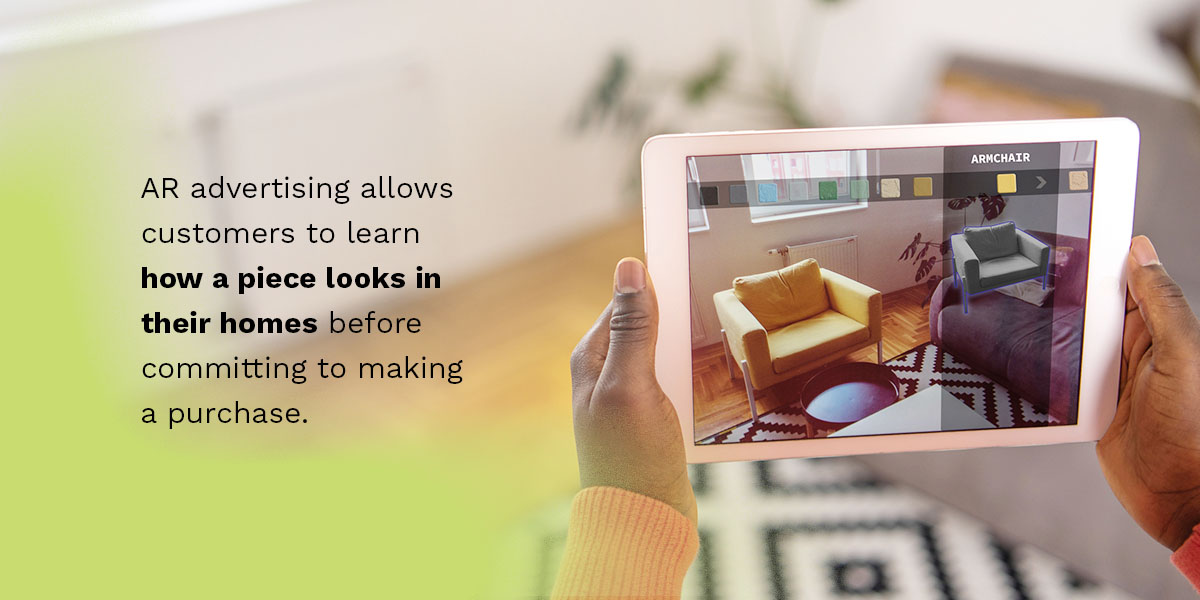
Travel and tourism
Why do consumers travel? Simple — they need an escape from the hustle of everyday life. Advertisers can tap into that need by creating engaging AR experiences that transport viewers to their dream vacations. The opportunities for out-of-home AR advertising in this industry are truly endless. A campaign for a travel agency could involve a rich media ad viewers could tap on to activate an interactive glimpse of a popular destination.
AR is great for enhancing travel experiences, as well. Some developers have created augmented tourist destination apps, which allow users to point their cameras at nearby businesses and historical sites and immediately receive information about those locations.
Say you’re visiting a new city and you’re looking for a place to eat lunch. As you’re walking, you could scan the different cafes you pass by to see important information like menus, business hours and even reviews, which can help you decide where to stop.
Fashion
Offering virtual try-ons is one of the most common applications of AR technology for advertising purposes. The ad uses input from the front-facing camera to apply a layer of clothing to the shopper’s image, allowing them to get an idea of how it looks in real life without ever needing to set foot in a store. More advanced AR programs can even incorporate adjustments for lighting and body shape to improve the image’s accuracy.
This functionality is a great way to increase online clothing sales, as customers will feel more comfortable buying items they know they’ll like than taking the leap to purchase items they might have to return.
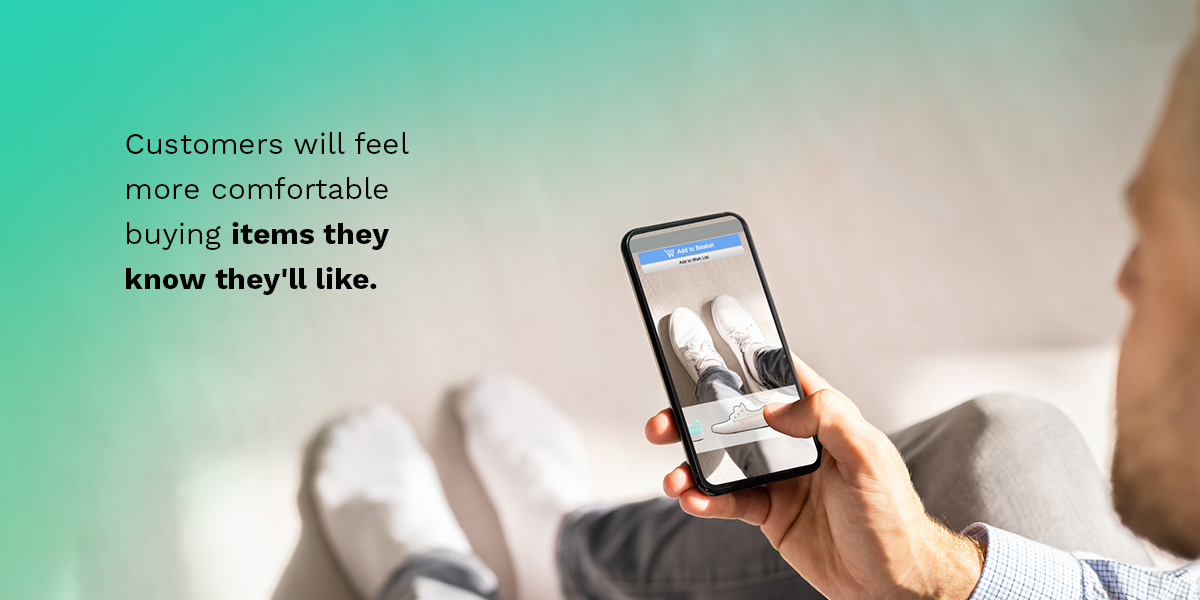
AR can also help build hype for upcoming launches. In 2020, Nike and AKQA created an AR experience for their Brazilian audience to promote their Air Max 2090 sneaker line. The campaign’s goal was to expand the launch’s reach beyond hardcore sneakerheads and connect with a broader, more mainstream audience. The campaign was successful — overall, the ad boosted Nike’s sales by 32% and increased site traffic by 22%.
Music and entertainment
Many entertainment companies have seen great success in incorporating AR in their ad campaigns.
In 2020, Canadian pop artist The Weeknd partnered with social media platform TikTok to promote his “After Hours” album through a live AR concert experience. The event, titled The Weeknd Experience, brought fans on a wild ride through the album’s dystopian universe. Users could control their experience through the live chat — in one notable scene, they could vote on whether The Weeknd’s character would lick a frog.
The Weeknd Experience was a massive success, bringing in more than two million total viewers and raising $350,000 for the Equal Justice Initiative.
3 unique applications of AR in advertising
Brands have come up with many different creative use cases for integrating AR into their ad campaigns. Here are some AR advertising examples from brands across a wide variety of sectors.
1. Marker-based
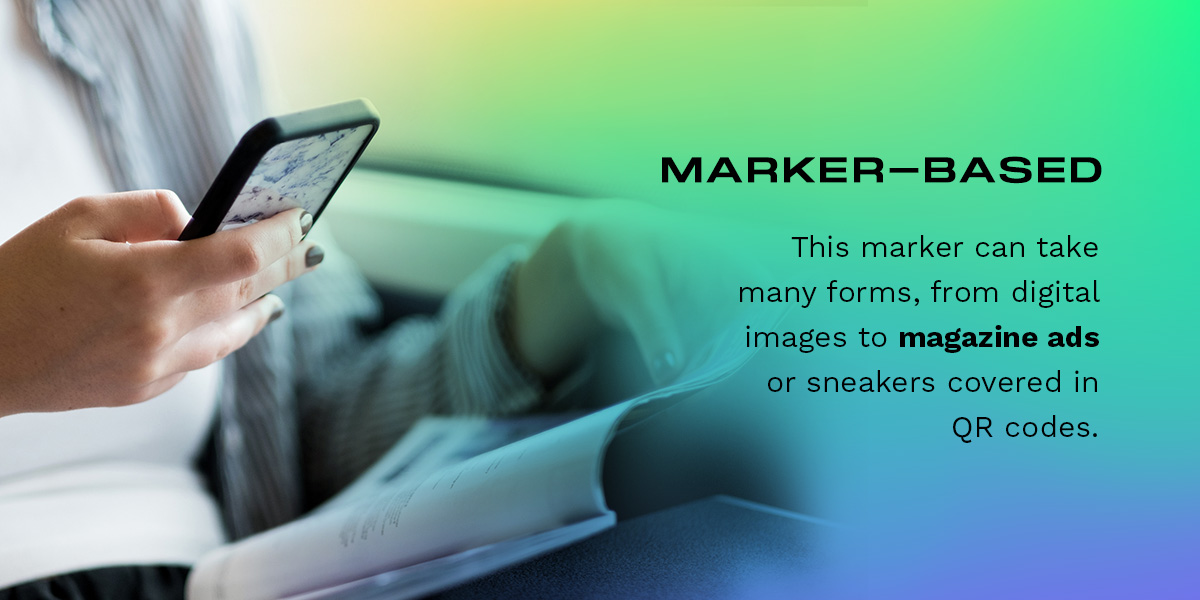
Marker-based AR is the most common type of AR ad integration and the easiest to create. You make a target image, or marker, users can scan with their smartphone to start the experience. This marker can take many forms, from digital images to magazine ads or sneakers covered in QR codes.
Burger King’s 2019 Escape the Clown campaign is among one of the best AR marketing campaigns using marker-based AR. The campaign, which dropped at the same time as the horror movie “It Chapter Two,” challenged McDonald’s customers to run to the nearest Burger King within a specified time limit. Those who made it got a Whopper for only one cent. The campaign successfully encouraged customers to leave competing McDonald’s restaurants and visit Burger King instead.
2. Experiential shopping
Creating a campaign that mixes AR advertising with in-person shopping enhances the customer experience and strengthens customers’ connection to the brand.
Burberry’s social retail store in Shenzhen, China, offers shoppers a unique AR experience store visitors could activate by scanning a product’s QR code. The code launches a mini program in the Chinese social network WeChat, which allows them to work toward unlocking rewards through social currency. The more the customer interacts with the brand, the richer their experience becomes.
The app is also highly functional, allowing users to access client services such as making reservations at the in-store cafe and booking in-store appointments.
3. Augmented reality portals
An AR portal is a kind of hybrid between AR and VR that allows you to view a totally virtual space in an AR environment. It works by overlaying a virtual door or portal into your camera feed, which you can walk through to enter the virtual world.
Often, brands will partner with tech companies like Snap Inc. to create AR portal advertisements. At the height of the pandemic in 2020, Gucci Beauty launched an interactive Snapchat campaign using the platform’s Portal Lens technology. When users activated the Gucci filter, they would be able to enter a portal that transported them to the Gucci Bloom Garden of Dreams.
Once in the garden, users would navigate a maze to find the hidden fragrance bottles and unlock surprises. A shower of rose petals would fall from the top of the screen when users found all five bottles. The ad would also encourage users to visit the Gucci website to purchase the Bloom fragrances.
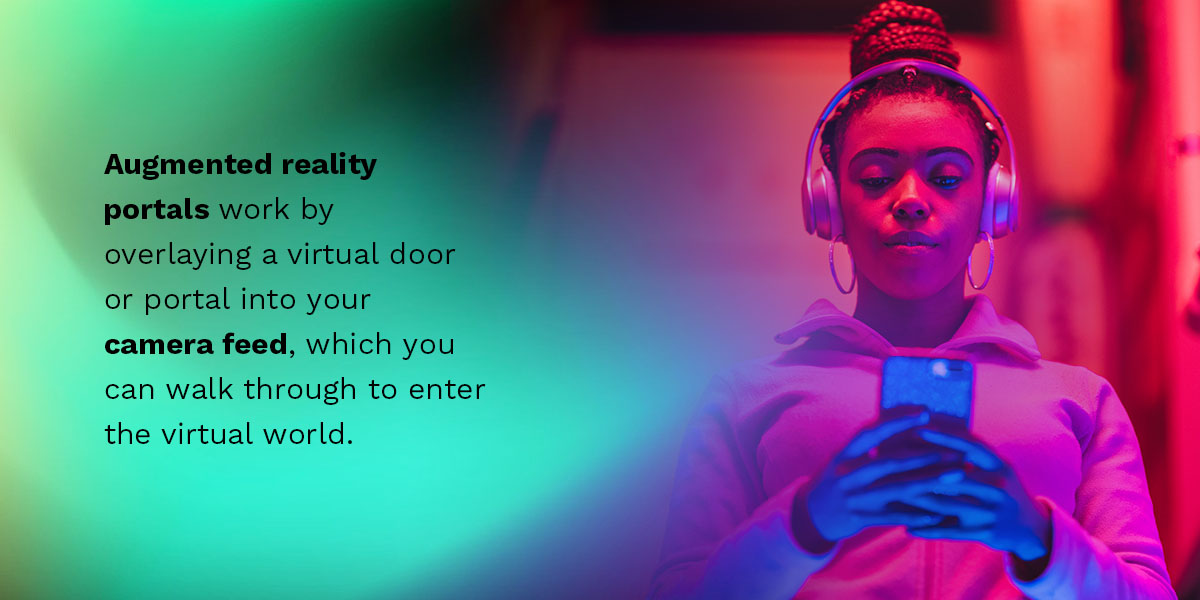
Challenges in the path of AR advertising
Although AR is a promising advertising technology, there are certain factors that limit its possibilities. Given the current technological landscape, it may be some time before AR reaches its full potential. Here are some of the boundaries you might run into when developing AR campaigns.
Smartphones are a must-have
One of the biggest barriers companies face in implementing AR advertising is that this strategy requires users to have smartphones or tablets with cameras. Many communities still lack access to this technology, so depending on where your audience is, you might be unable to reach them.
Most AR ad experiences rely on a mobile app to host their content. However, some tech companies are working on creating new media formats that can run AR ads without a dedicated app. This new solution, called augmented reality digital placement (ARDP), would allow users to access the AR experience simply by tapping on a rich media ad.
There are hardware limitations
Like with any digital application, your campaign is limited to what a user’s device can withstand. AR is a particularly demanding technology, as it requires the device to perform multiple functions simultaneously:
- Keep the camera activated
- Receive input from the camera feed
- Process ad data using a wireless connection
- Render graphics and animations on the screen
When combined, these tasks consume significantly more power, and the experience can end prematurely if the user’s battery dies.
The current graphics processing capacity of smartphones is another limiting factor. Think about playing video games or watching videos on YouTube. A good experience in most cases depends on high resolution and speed. Most smartphones fall short of the processing power of desktops and gaming consoles, which can make it more difficult for users accustomed to 1080p resolution and advanced graphics to become fully immersed in the ad.
That said, each new generation of smartphone is more AR-capable than the last. We’re likely to see highly sophisticated mobile AR experiences become common as technology evolves.
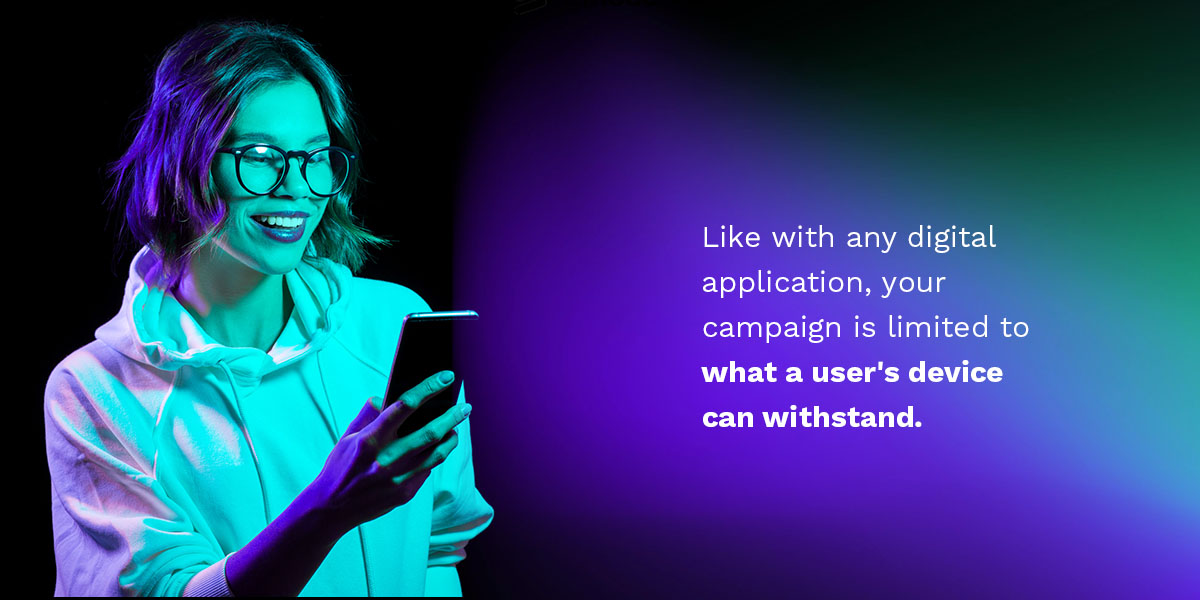
Network availability limits experiences
As it is, AR relies on a strong high-speed internet connection to work properly. 4G networks, which are the current standard, can only handle data download speeds around 100 megabytes per second. Anything larger overloads the network, which slows the experience and leads to high bounce rates.
The increasing adoption of 5G is sure to unlock the full potential of AR advertising. With ultra-low latency and data speeds of multiple gigabytes per second, 5G-enabled AR trials of products and services will render better than ever before. A simple overlay of a pink lip gloss on a customer’s lips will reflect all the glitter and shine of the real thing, even sparkling in time with the natural light.
Here’s a quick rundown of how 5G will improve future AR advertising campaigns:
- Enhanced interactivity: Better processing speed means developers can get more in-depth when programming 3D asset interactions with input from the user’s physical environment. This can inspire higher buyer confidence and help to close more sales.
- Fewer product returns: Highly interactive digital assets enable users to gain a more complete understanding of what a product is and how it works. This helps them determine whether the product fits into their lives, increasing the likelihood that they will be satisfied with their purchase.
- Increased sales and conversions: Engaging AR experiences are more effective at building a user’s interest in a product than traditional display ads, drawing more customers through the sales funnel.
- Better product representation: Higher-speed networks would allow animations and filters to be more photorealistic, more accurately reflecting how a product appears in the real world. This will be especially beneficial for the beauty and fashion industries, as they rely heavily on product appearance to make sales.
- More satisfied customers: When customers know what they’re buying and why they need it, they’re more likely to be happy with their purchase. Plus, better AR experiences help impress viewers and inspire stronger brand loyalty.
5G adoption will be slower in some areas than in others. Thinking carefully about your target audience and their access to technology will be essential in creating an ad campaign that makes sense for your application.
Software development skills are a must
You need people with technical expertise to develop AR advertising campaigns. While many companies offer AR software development kits (SDKs) you can use to build these experiences, strong coding skills are still necessary to use them.
Even many prominent advertising agencies lack the resources necessary for using SDKs, which means they have to outsource these projects to companies or independent developers who have the right experience. Finding the right match is important here — you want to make sure your advertising partner can provide the support you need to create high-quality 3D assets that make your campaign stand out.
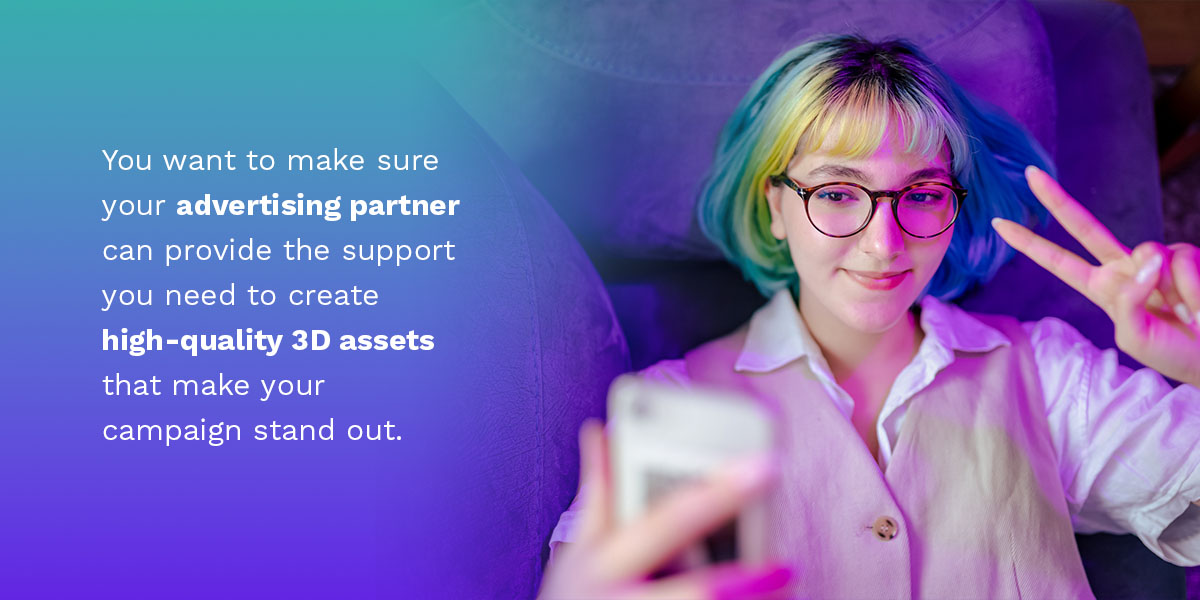
How Emodo can help
If you’re looking for a way to get started with AR advertising, consider working with Emodo. Our AR-based campaigns have generated overwhelmingly positive results in the past.
By embedding the AR experience into the ad itself, we can provide greater reach and scale than previously possible. Emodo Adapt, our advanced native ad format, allows us to create AR ads tailored to your specific audiences to delight viewers and drive conversions.
Just look at how our Broadway Show Globe campaign captivated audiences. Overall, the campaign garnered 90% engagement from users, who spent an average of three minutes and 12 seconds on the ad. That’s seven times what users spend on traditional digital creative on average. Here are some of the other figures from this campaign:
- 22% of viewers shared the experience on social media
- 9 of the top 10 performing shows saw an increase in sales
- 10% of the budget accounted for nearly 30% of audience engagement
AR brings customers into the sales funnel and guides them through to the point of sale. A dynamically adaptive AR ad format can help meet your audience where they are and hold their attention, increasing conversions and driving more successful campaigns.
Build better ad creative with Emodo
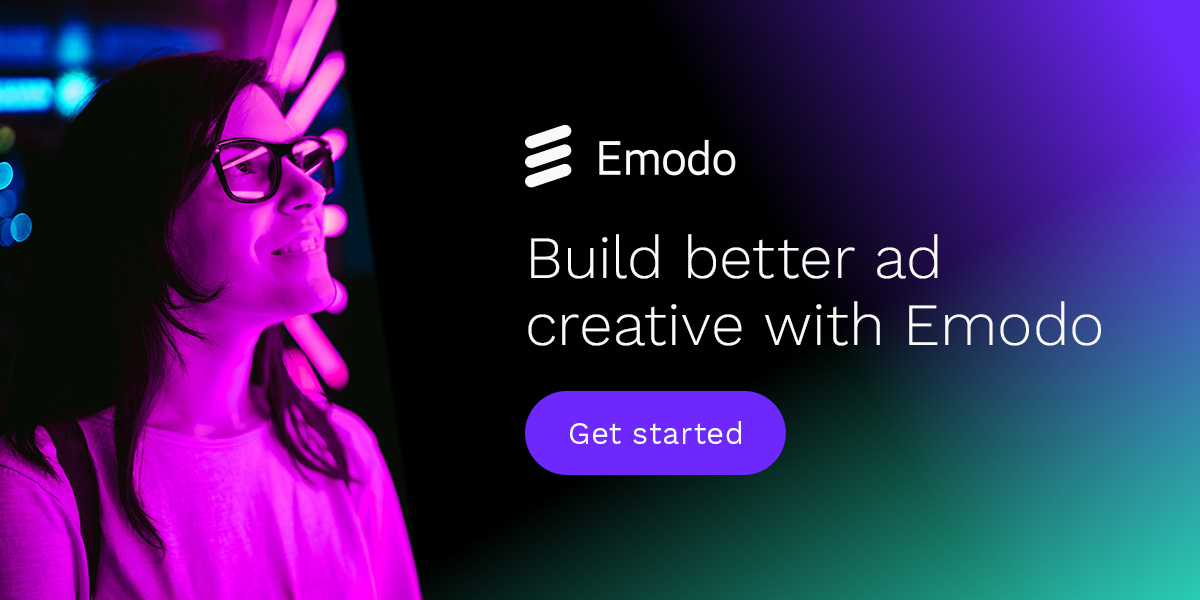
Getting on the AR trend now is key for getting ahead of the curve, especially as AR technology becomes more easily accessible. That’s why you need to work with an experienced advertising organization like Emodo. We’ll help you create breathtaking AR experiences to reach your audiences and stay in their memory.
With Emodo Adapt, you can create rich, high-performing ads that dynamically adapt to ever-evolving KPIs. Plus, our contextual solution can help future-proof audience targeting so you can be sure you’re speaking to the right people, even as you scale.
Want to see how AR can push your ad campaign to the next level? Reach out to us today to get started.
MORE LIKE THIS


